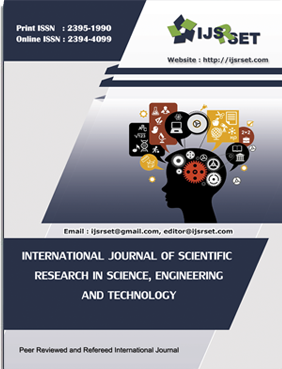Determination of Water Quality Index of Drinking Water in Aligarh District, UP, India
DOI:
https://doi.org/10.32628/IJSRSET2411419Keywords:
Water Quality Index, Physico-Chemical Parameters, Water Quality StandardsAbstract
Water is perhaps the most precious natural resource after air. Though the surface of the earth is mostly consists of water, only a small part of it is usable, which makes this resource very limited. This precious and limited resource, therefore, must be used with prudence. As water is required for different purposes, the suitability of it must be checked before use. Nowadays fresh water cannot be used directly for drinking purposes due to contamination and pollution. So treatment is used before it is used for drinking or for industrial processes. Also, sources of water must be monitored regularly to determine whether they are in sound health or not. Poor condition of water bodies are not only the indictor of environmental degradation, it is also a threat to the ecosystem. In industries, improper quality of water may cause hazards and severe economic loss. Thus, the quality of water is very important in both environmental and economic aspects. Thus, water quality analysis is essential for using it in any purpose. The quality of water depends upon its source of history. The history of water signifies the terrain through which water is flowing, its origin and most important the extent to which it is contaminated on its way by impurities, sediments and industrial waste. The solubilisation and fragmentation of the terrain through which it flows determines its quality. The extent of dissolved solid materials present in water decides its quality. Such quality is also decided by the solubility of the geological deposits, contact of water with sediments, time of interaction and special factors related to environment. To ascertain suitability of water for consumption, it is necessary to undertake examination of quality of water. . Major information on the quality of water is obtained by physical examination. considered in the present paper for calculating the WQI such as pH, Total alkalinity, Calcium, Magnesium, Chloride, Sulphate, Nitrate and also calculated the seasonal variations of physio- chemical parameters of water quality of Aligarh District.
📊 Article Downloads
References
Abebe, B. G., 2013. Urban Water Supply in Addis Ababa: Problems and Prospects,Approved Ph. D. Thesis in Geography, Banaras Hindu University. Varanasi, p. 156
Bates, R., 1973. Determination of pH: theory and practices, Wiley and sons, New York, USA.
Benjamin R., Chakrapani, B. K., Naarthana A. V., Ramchandra, T. V., 1996. Fish Mortality in Bangalore Lakes, India. Electric Green Journal, 1 (6): pp.73-79. DOI: https://doi.org/10.5070/G31610252
Bilas, R., 1988. Rural Water Resource Utilization and Planning: A Geographical Approach in Varanasi District. Concept Publishing Company, New Delhi.
B. Nemade, J. Nair, and B. Nemade, "Efficient GDP Growth Forecasting for India through a Novel Modified LSTM Approach," Communications on Applied Nonlinear Analysis, vol. 31, no. 2s, pp. 339-357, 2024. DOI: https://doi.org/10.52783/cana.v31.653
B. Marakarkandy, B. Nemade, S. Kelkar, P. V. Chandrika, V. A. Shirsath, and M. Mali, "Enhancing Multi-Channel Consumer Behavior Analysis: A Data-Driven Approach using the Optimized Apriori Algorithm," Journal of Electrical Systems, vol. 20, no. 2s, pp. 700–708, 2024. DOI: https://doi.org/10.52783/jes.1536
B. Nemade, N. Phadnis, A. Desai, and K. K. Mungekar, "Enhancing connectivity and intelligence through embedded Internet of Things devices," ICTACT Journal on Microelectronics, vol. 9, no. 4, pp. 1670-1674, Jan. 2024, doi: 10.21917/ijme.2024.0289.
B. Nemade, S. S. Alegavi, N. B. Badhe, and A. Desai, “Enhancing information security in multimedia streams through logic learning machine assisted moth-flame optimization,” ICTACT Journal of Communication Technology, vol. 14, no. 3, 2023.
S. S. Alegavi, B. Nemade, V. Bharadi, S. Gupta, V. Singh, and A. Belge, “Revolutionizing Healthcare through Health Monitoring Applications with Wearable Biomedical Devices,” International Journal of Recent Innovations and Trends in Computing and Communication, vol. 11, no. 9s, pp. 752–766, 2023. [Online]. Available: https://doi.org/10.17762/ijritcc.v11i9s.7890. DOI: https://doi.org/10.17762/ijritcc.v11i9s.7890
V. Kulkarni, B. Nemade, S. Patel, K. Patel, and S. Velpula, "A short report on ADHD detection using convolutional neural networks," Frontiers in Psychiatry, vol. 15, p. 1426155, Sept. 2024, doi: 10.3389/fpsyt.2024.1426155. DOI: https://doi.org/10.3389/fpsyt.2024.1426155
Bilas, R., 1981. Rural Water Supply in Varanasi District: A Geographical Appraisal of Water Resources, its Utilization and Planning. Approved Ph.D. Thesis in Geography, Banaras Hindu University. Varanasi (Published). p. 1.
BIS, 1993.Bureau Indian Standard specification for Drinking Water, New Delhi.
Choudhary P, Routh J, Chakrapani G.J., 2010. Organic geochemical record of increased productivity in Lake Naukuchiyatal, Kumaun Himalayas, India. Environ Earth Science, 60 (4): pp. 108-113. DOI: https://doi.org/10.1007/s12665-009-0221-3
Chow, V. T. ed., 1964. Handbook of Applied Hydrology, McGraw Hill, New York
Downloads
Published
Issue
Section
License
Copyright (c) 2024 International Journal of Scientific Research in Science, Engineering and Technology

This work is licensed under a Creative Commons Attribution 4.0 International License.




